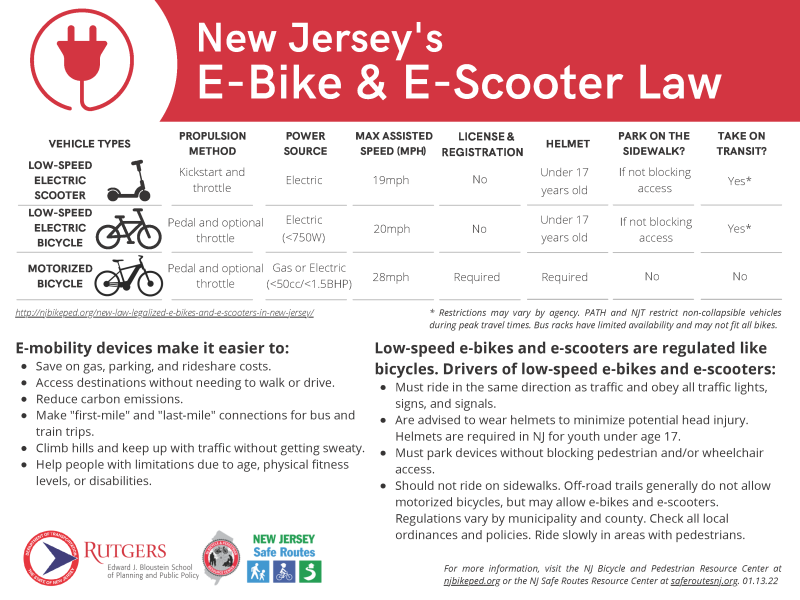As the weather warms, school lets out and summer kicks into full swing, New Jersey residents are being reminded of the rules and regulations around electric bicycles, a form of transportation that has rapidly grown in popularity over the last several years.
“In recent years, micromobility options like e-bikes and e-scooters have become increasingly popular forms of transportation for both commuting and leisure, offering a sustainable and efficient alternative to traditional transportation methods,” reads the NJDOT Bicycle and Pedestrian Resource Center‘s micromobility guide.
Between 2019 and 2022 the U.S. e-bike market grew 269%, ABC News reported. According to the U.S. Department of Energy, 1.1 million e-bikes were sold in the United States in 2022, almost four times as many as 2019.
As micromobility use has grown, New Jersey state legislature has passed multiple laws that impact micromobility users. For example, in 2019 Gov. Phil Murphy signed legislation that solidified these devices’ status under the law and outlined regulations governing their use.
In 2022, the governor signed the Safe Passing Law, requiring drivers to approach and pass vulnerable users, such as pedestrians or cyclists, with “due caution” by slowing down and providing a minimum of four feet while passing.
Now, as we head into the summer, several local police departments have taken to social media to remind residents and parents of the state’s rules and regulations surrounding e-bikes.
“There seems to be a lot of confusion about what’s legal and what’s not when it comes to electric vehicles,” wrote the Montville Township Police Department in a post on Facebook, advising residents and parents to “take a moment to read and understand the laws.”
“As the weather warms up and more of our residents turn to electric scooters, e-bikes and motorized bicycles to get around, we want to share a few important reminders to help keep everyone safe on our roadways,” wrote the Glen Ridge Police Department in a post on Facebook. “While these micromobility devices are fun, efficient, and environmentally friendly, it’s essential they’re used safely and within the law.”
The Hanover Police Department echoed this statement in a post on Facebook, advising parents to speak with their children about safe riding practices and to help ensure that they are using the correct type of e-bike or scooter.
Before hitting the road for your next ride, let’s take a look at what the law says about e-bikes in New Jersey.
New Jersey’s e-bike laws and classifications
E-bikes typically come in two forms, according to the NJDOT Bicycle and Pedestrian Resource Center. Pedal assist bicycles give you extra power while you are already pedaling and throttle bicycles allow you to move forward using only the motor.
Under previous regulations, e-bikes were classified as motorized vehicles, or mopeds, and registration with the Motor Vehicle Commission was required. However, the MVC system would not allow registration as the law was written specifically for gas powered vehicles, according to the Bicycle and Pedestrian Resource Center.
So, in 2019, a brand-new vehicle class known as low-speed electric bicycles was added to Title 39 of the New Jersey Statutes, the statewide set of laws related to traffic and motor vehicle regulations. The new law allowed for both pedal assist and throttle bicycles.
Under state law, pedal assist bicycles fall under class 1 low-speed electric bicycles and throttle bicycles fall under class 2. Overall, according to the Bicycle and Pedestrian Resource Center, low-speed electric bicycles must have a maximum speed of 20 mph, be 750 watts or less and may be pedal assist or throttle powered.
License, insurance and registration are not required for low-speed electric bicycles. However, operators must follow all laws applicable to traditional bicycles.
Helmet use is required for those under 17 years old.
For additional information on bicycle laws, visit https://njbikeped.org/bicycle-laws/.
Class 3 motorized bicycles: License, registration and insurance required
Class 3 motorized bicycles, such as mopeds, require a license, registration and insurance as well as helmet use. Per the BPRC, these vehicles include electric pedal bicycles that can reach between 20 and 28 mph as well as gas pedal bicycles with maximum piston displacement under 50 cc.
Municipal regulations may vary
In New Jersey, individual municipalities may have their own regulations for micromobility devices such as where they are permitted or age-based restrictions.
“Before riding, it is best to familiarize yourself with the local regulations in your town and the towns you visit or ride through,” says the Bicycle and Pedestrian Resource Center.
NJ Micromobility Guide
For more details and safety tips, check out the NJDOT Bicycle and Pedestrian Resource Center’s full micromobility guide at https://njbikeped.org/new-jersey-micromobility-guide-2025/.
Source: northjersey.com
